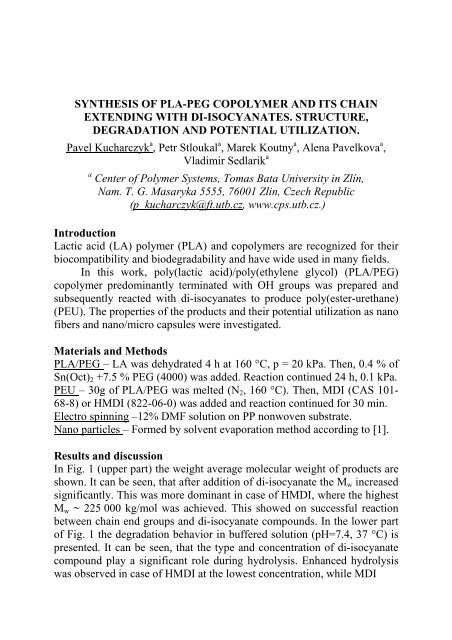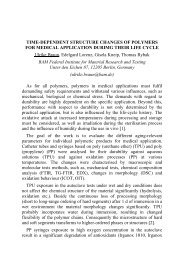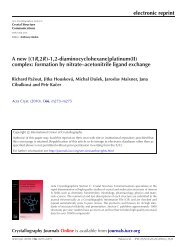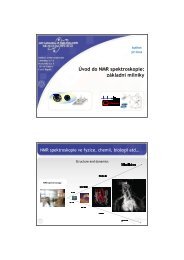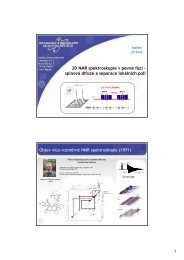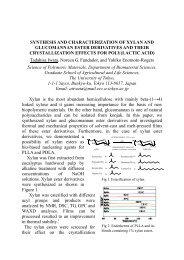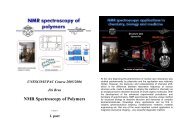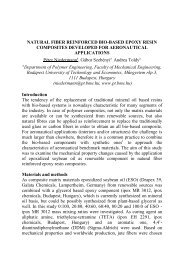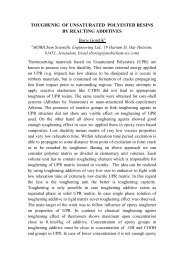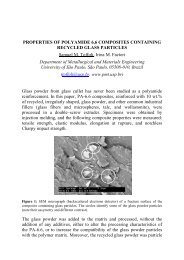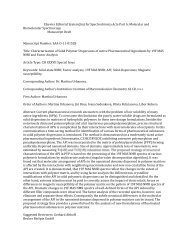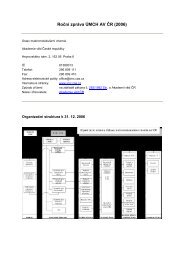SYNTHESIS OF PLA-PEG COPOLYMER AND ITS CHAIN ...
SYNTHESIS OF PLA-PEG COPOLYMER AND ITS CHAIN ...
SYNTHESIS OF PLA-PEG COPOLYMER AND ITS CHAIN ...
Create successful ePaper yourself
Turn your PDF publications into a flip-book with our unique Google optimized e-Paper software.
<strong>SYNTHESIS</strong> <strong>OF</strong> <strong>PLA</strong>-<strong>PEG</strong> <strong>COPOLYMER</strong> <strong>AND</strong> <strong>ITS</strong> <strong>CHAIN</strong><br />
EXTENDING WITH DI-ISOCYANATES. STRUCTURE,<br />
DEGRADATION <strong>AND</strong> POTENTIAL UTILIZATION.<br />
Pavel Kucharczyk a , Petr Stloukal a , Marek Koutny a , Alena Pavelkova a ,<br />
Vladimir Sedlarik a<br />
a Center of Polymer Systems, Tomas Bata University in Zlín,<br />
Nam. T. G. Masaryka 5555, 76001 Zlin, Czech Republic<br />
(p_kucharczyk@ft.utb.cz, www.cps.utb.cz.)<br />
Introduction<br />
Lactic acid (LA) polymer (<strong>PLA</strong>) and copolymers are recognized for their<br />
biocompatibility and biodegradability and have wide used in many fields.<br />
In this work, poly(lactic acid)/poly(ethylene glycol) (<strong>PLA</strong>/<strong>PEG</strong>)<br />
copolymer predominantly terminated with OH groups was prepared and<br />
subsequently reacted with di-isocyanates to produce poly(ester-urethane)<br />
(PEU). The properties of the products and their potential utilization as nano<br />
fibers and nano/micro capsules were investigated.<br />
Materials and Methods<br />
<strong>PLA</strong>/<strong>PEG</strong> – LA was dehydrated 4 h at 160 °C, p = 20 kPa. Then, 0.4 % of<br />
Sn(Oct) 2 +7.5 % <strong>PEG</strong> (4000) was added. Reaction continued 24 h, 0.1 kPa.<br />
PEU – 30g of <strong>PLA</strong>/<strong>PEG</strong> was melted (N 2 , 160 °C). Then, MDI (CAS 101-<br />
68-8) or HMDI (822-06-0) was added and reaction continued for 30 min.<br />
Electro spinning –12% DMF solution on PP nonwoven substrate.<br />
Nano particles – Formed by solvent evaporation method according to [1].<br />
Results and discussion<br />
In Fig. 1 (upper part) the weight average molecular weight of products are<br />
shown. It can be seen, that after addition of di-isocyanate the M w increased<br />
significantly. This was more dominant in case of HMDI, where the highest<br />
M w ~ 225 000 kg/mol was achieved. This showed on successful reaction<br />
between chain end groups and di-isocyanate compounds. In the lower part<br />
of Fig. 1 the degradation behavior in buffered solution (pH=7.4, 37 °C) is<br />
presented. It can be seen, that the type and concentration of di-isocyanate<br />
compound play a significant role during hydrolysis. Enhanced hydrolysis<br />
was observed in case of HMDI at the lowest concentration, while MDI
Figure 1 – The M w (up) and degradation<br />
profiles (lower) of PEU products.<br />
Figure 2 – SEM images of nano<br />
fibers (up) and particles (down).<br />
provided more stable products (compact even after 90 days). Fig. 2 depicts<br />
nano fibers and particles successfully formed from prepared PEU. It can be<br />
seen, that in case of fibers (10 layers) the combination of nano and micro<br />
structures was achieved, which can be beneficial for example in filtration<br />
technology. In case of microparticles, the average diameter was found to<br />
be about 200 nm (light scattering, not presented) and they can be utilized in<br />
the area of encapsulation.<br />
Conclusions<br />
Poly(ester urethane) based on <strong>PLA</strong>/<strong>PEG</strong> copolymer was prepared. It can be<br />
successfully utilized in nano/micro fabrication like, fibers and particles.<br />
Acknowledgements<br />
The study was supported by project IGA (Grant IGA/FT/2012/005).<br />
References<br />
1. Stloukal P., Kucharczyk P., Sedlarik V. et al., J. Agric. Food Chem. 60: 4111−4119, 2012.


